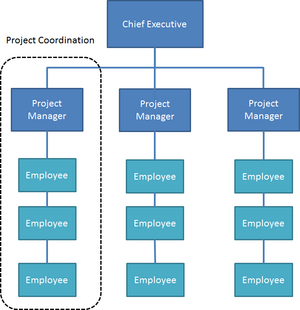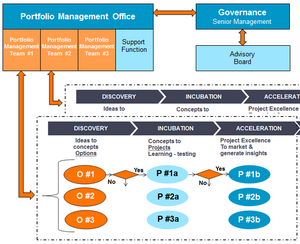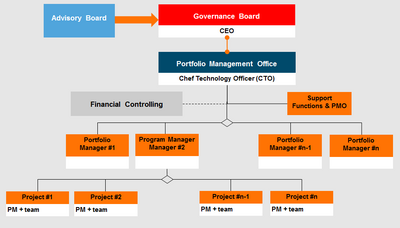The importance of Organizational Structures in Portfolio Management
| Line 111: | Line 111: | ||
'''Kates, A. & Kesler, G. (2011). ''Leading Organization Design: HOW TO MAKE ORGANIZATION DESIGN DECISIONS TO DRIVE THE RESULTS YOU WANT'' (1st edit.). San Francisco: Jossey-Bass.''' | '''Kates, A. & Kesler, G. (2011). ''Leading Organization Design: HOW TO MAKE ORGANIZATION DESIGN DECISIONS TO DRIVE THE RESULTS YOU WANT'' (1st edit.). San Francisco: Jossey-Bass.''' | ||
| − | The book address the subject of leading organization design and | + | The book address the subject of leading organization design and how to drive the organization in the wanted direction. It gives an introduction to how you can, on the basis of certain criterias and demands, lead and design organizations. |
Revision as of 18:58, 28 February 2019
Contents |
Abstract
The success of any organization – being a commercial company, public or non-profit organization – is highly dependent on the level of alignment the organization is able to execute on. The mission and vision statement of an organization expresses the end goal – the North Star. In order to achieve these goals, a strategy – the game plan of how to get there – is formulated. In order to execute on the strategy, a carefully selected collection of capabilities that suits and enables the strategy most be established - the organizational setup and design is critical. The success criteria’s of and the organizations ability to execute right projects is closely linked to their ability to design and structure the organization [1][2]. The purpose of introducing Project Portfolio Management (PPM) is to establish and formalize an entity that provides insight and transparency for the senior management to constantly align the activities (projects) with the strategy and thereby utilizing the limited economic and human resources of the organization in the best possible way [3].
The introduction of PPM as a collection business practices impose complexity on to the organization that cannot be accommodated by the classical organizational structures. The purpose of this article is to address and stress the importance of organizational design - including organizational structures needed for a Project Portfolio Management organization to be effective in and co-existence with a classical line organization - in order for the enterprise to become successful. The article addresses the important concepts and the application of how to obtain an optimal organization design that is needed to execute on the strategy of the organization. It provides the tools and accumulated experience in order to become a good and successful practitioner.
Background - Managing portfolios
Project Management is a mature discipline with a great variety of tools supporting the project manager and team to timely delivery of the right product or service at the right level of quality; however the real value is only harvested when the completion of the project benefits the business and improve the competitive position. The rapid changes in the competitive landscape require constant alignment with the strategic direction of the enterprise. Projects constantly not being monitored and assessed with focus on benefit, risk and alignment with the overall strategy of the enterprise tend to fall short and potentially drain the organization of financial and human resources at the expense other more beneficial projects. One way of dealing with the increase in complexity and the significant increase in the use of projects as a method to deal with challenges is to introduce the business practice of Project Portfolio Management [3]
In the highly recommendable book on Project Folio Management by Levine PPM is defined as “Project portfolio management is a set of business practices that brings the world of projects into tight integration with other business operations. It brings projects into harmony with the strategies, resources, and executive oversight of the enterprise and provides the structure and processes for project portfolio governance”(Levine, 2005, p. 1)[3]. The successful implementation of PPM requires a transformation of the organization involving significant changes to the roles and responsibilities of not just the upper management level but to the entire organization - a new organizational design is needed.
Organizational structures
An organizational structure is a formal visualization of a system of tasks and the reporting relations, which coordinates and motivates the employees, enabling them efficiently to work together and to achieve the goals of the organization. Having an organizational structure can help the organization improve efficiently by balancing the influencing factors such as external environment, strategy, technology and human resources [4][5]. There are several types of organizational structures and these will be listed and elaborated below. It can be a comprehensive task to select and design a proper structure for an organization, which cater for the desired increase in efficiency and effectiveness of the organization. Organizational structuring is all about placing your resources and getting the most out of them as possible. The organizational structure should be perceived as dynamic tool to optimize the business, and adaptions and changes must be executed when needs occur, however it is important to notice that changes will create uncertainty among the employees and will result in resistance – transparency and open communication is perceived as one of the most effective measures to apply.
The success of any organization – being a commercial company or non-profit organization – is highly dependent on the level of alignment the organization is able to execute on. It is therefore important to focus on the structure of the organization and make a virtue out of designing the best possible structure that suits the organization and its goals. If the organizational structure is not in alignment with the strategy of the organization, it creates friction which shows the inability to mobilize resources right, decision-making and information flow lacks, and the execution of the strategy becomes ineffective [1][2].
Differences in structures
As mentioned above, there are several types of organizational structures. Below is a short description of the different main types of organization structures including the advantages and disadvantages of these. The structure can be selected and designed in order to fit your organization – there is no “fit it all” structure. The following structures has been selected as relevant for this article
Functional structure
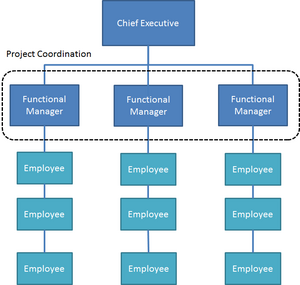
[4]The functional structure is the structure of an organization composed of the departments of the organization, that is required in order to fulfill the services and/or manufacturing of an enterprise. The function in this context is a grouping of employees, who hold the same knowledge or field of work. The functional organization structure is typically the first the manager looks into and groups jobs into departments. The individual department usually works independently and isolated from the other departments and report to a functional manager. The functional manager are the one in control of project budgets and allocation of resources, which means the project managers will have limited authority and more act as coordinators than ‘leaders’.
Advantages of a Functional oriented organization[4][1][2]
- Good for small teams or projects since the function has control over the team members and resources required.
- Easy access to “experts” - since they are in same functional unit.
- Easy and quick to gather people when needed (e.g. to resolve project related problems)
- Relative small and simple teams and communication system.
- Centralized resources – ensures sustainability in the organization (the knowledge remain in the individual department)
Disadvantages of a Functional oriented organization[4][1][2]
- The organizational structure is primarily applicable for ongoing operations rather than projects
- The work is kept to the individual functional division and isolated to the others.
- Project management is usually underestimated and is reflected in the success of projects.
- Project Managers has no or little authority - the employees in each function reports to the functional manager, and the project manager therefore loses authority on the project team.
- The people on the project team may be more loyal to their own department rather than the work on the project team – creates conflicts.
- No real opportunity to network across the functions.
Matrix structure
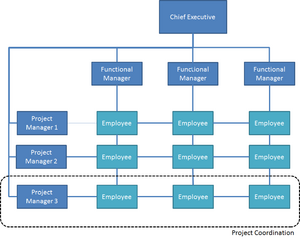
[4]The Matrix structure is a structure that groups people and resources by function and by product. This means that the employees of the organization are grouped by their function in order to become more skilled and learn from each other. Furthermore, they are grouped in project or product teams in order to create a diverse group with different skillset and functions that shall develop a specific product. This creates a higher complexity within the reporting network but gives the matrix structure flexibility.
Advantages of the matrix structure:[4][1][2]
- Allow managers to make flexible choices
- Authority to both project managers and functional managers – building a strong culture within the teams across divisions.
- Very flexible – resources are used more efficiently since it can be moved between project as needed.
- Work on different things in parallel.
- Team members maintain a home – When a project is finished and they are released, they return to their department and focus on their “business-as-usual” assignments.
Disadvantages of the matrix structure:[4][1][2]
- Two bosses/managers
- Conflicts (e.g. resource conflicts, between projects, etc.) between project and functional managers.
- Conflicts between “business-as-usual” assignments and project work for the individual – functional managers are likely to have different priorities than project managers.
- Extensive policies and procedures.
Projectized structure
[4][5]The projectized structure is a structure that groups people and resources by project or product teams. This gives the project manager complete authority of the project and the resources. The projectized organization has rarely a functional manager. This structure work by arranging the different projects into programs or portfolios and execute on them as projects.
Advantages of a projectized structure[4][1][2][5]
- Efficient project organization – by this is meant that all resources are focused and dedicated to the project assignments. This also eases the scheduling of work
- Loyalty to the project and the project manager – the team only needs to focus on the team’s goals, they do not have other assignments than the project related.
- More effective communication than functional – the project team usually work in the same location (or room) which increased the efficiency of the communication significantly.
- The project manager is in control.
Disadvantages of a projectized structure[4][1][2][5]
- No “home” when project is finished – if there is not a new project after the project has reached its end, the resources are released. Closing a project can mean losing your job.
- Lack of professionalism in disciplines – the above mentioned disadvantage can result in lack of professionalism, because when an employee is released, the person’s “know-how” and experience will be lost as well.
- Duplication of facilities and job functions – the resources and tools only belong to one project in the organization at one time.
- Less efficient use of resources – The resources are dedicated to one project only and they cannot be allocated to another task, this creates inefficiency.
- Project managers do line management as well in this structure – this means spending time and effort on human resource tasks.
Creating the optimal Project Portfolio Management organizational structure
The introduction of Project Portfolio Management is a cultural transformation that strong top-level management commitment – walks the talk – and a few highly skilled, respected and committed “ambassadors” that can drive this cultural transformation. However, culture and cultural changes are not a design parameter that can be demanded, it is the outcome of an organizational design [1][2].
The scope of PPM begins with prepared the proposed project (options) against a set of well-defined selection criteria making sure that only relevant project are ranked and presented. It is significant importance that the PPM organization is having the right information and can determine the witch project that will enter the next stage and witch that will be trashed. The PPM organization must liaise and connects the project with the business. The evaluation is determined based on strategic fit, risks/uncertainty and benefits for the corporation; it is essential for the optimal utilization of the financial and human resources of the enterprise. When project is approved and moves to the active stage, the project enters the performance monitoring where the task of the PPM is to evaluate the project against the selection criteria and the project goal. This phase will clarify project uncertainty that along with performance deficiencies could result in postponement, re-shaping and even termination of the project. The tail of the project tend to be under estimated, but is where the project spend is transformed into business opportunities – the product enters the finalization and maintenance phase (project excellence). Depending on the type enterprise/organization, e.g. pharma, software or public service, the steps and procedures are often governed by a stage gate model adapted to the nature of the projects being executed.
Application/Usability
AnneD1
AnneD2
Challenges and Limitations
Annotated Bibliography
Jones, G. R. & George, J. M. (2015). Essentials of Contemporary Management(5th edit.). New York: McGraw-Hill Education, Chapter 7.
To learn more about the basics of management, the Essentials of Contemporary Management is a good read. Chapter 7 describes the designing of organizational structures from an organizational management point of view; including a more in-depth elaboration on each of the structures and the choices of why a certain structure is chosen by the managers. The book provides a good basis knowledge on the subject of Organizational Management hereunder advantages/disadvantages and examples.
Kates, A. & Kesler, G. (2011). Leading Organization Design: HOW TO MAKE ORGANIZATION DESIGN DECISIONS TO DRIVE THE RESULTS YOU WANT (1st edit.). San Francisco: Jossey-Bass.
The book address the subject of leading organization design and how to drive the organization in the wanted direction. It gives an introduction to how you can, on the basis of certain criterias and demands, lead and design organizations.
Levine, H. A. (2005). Project Portfolio Management: A Practical Guide to Selecting Projects, Managing Portfolios, and Maximizing Benefits. Jossey-Bass
This is a book on project portfolio management (PPM). It provides the reader with a step by step run-through of how to create a portfolio and how to manage it. The book gives the tools and guidance to understand the implications of managing a project portfolio office.
References
- ↑ 1.0 1.1 1.2 1.3 1.4 1.5 1.6 1.7 1.8 Kates, A. & Kesler, G. (2011). Leading Organization Design: HOW TO MAKE ORGANIZATION DESIGN DECISIONS TO DRIVE THE RESULTS YOU WANT (1st edit.). San Francisco: Jossey-Bass.
- ↑ 2.0 2.1 2.2 2.3 2.4 2.5 2.6 2.7 2.8 Kates, A. & Galbraith, J. (2007). Designing Your Organization: Using the Star Model to Solve Five Critical Design Challenges.
- ↑ 3.0 3.1 3.2 3.3 Levine, H. A. (2005). Project Portfolio Management: A Practical Guide to Selecting Projects, Managing Portfolios, and Maximizing Benefits. Jossey-Bass.
- ↑ 4.00 4.01 4.02 4.03 4.04 4.05 4.06 4.07 4.08 4.09 4.10 4.11 4.12 Jones, G. R. & George, J. M. (2015). Essentials of Contemporary Management(5th edit.). New York: McGraw-Hill Education, Chapter 7.
- ↑ 5.0 5.1 5.2 5.3 5.4 5.5 Project Management Institute, Inc.. (2017). Guide to the Project Management Body of Knowledge (PMBOK® Guide) (6th Edition). Project Management Institute, Inc. (PMI), Chapter 2. Retrieved from https://app.knovel.com/hotlink/pdf/id:kt011DX0C1/guide-project-management/environmen-overview
- ↑ O'Connor, G. C., Leifer, R., Paulson, A. S., & Peters, L. S. (2008). Grabbing Lightning. San Francisco: Jossey-Bass.
- ↑ Hyland, J., & Arteaga, R. (2014). Pivot: How Top Entrepreneurs Adapt and Change Course to Find Ultimate Success. New Jersey: John Wiley & Sons.
- ↑ Cooper et al 2001
- ↑ Office Of Government Commerce (2011). Management of Portfolios. London: TSO.
Cite error: <ref> tag with name "Leaduser" defined in <references> is not used in prior text.
